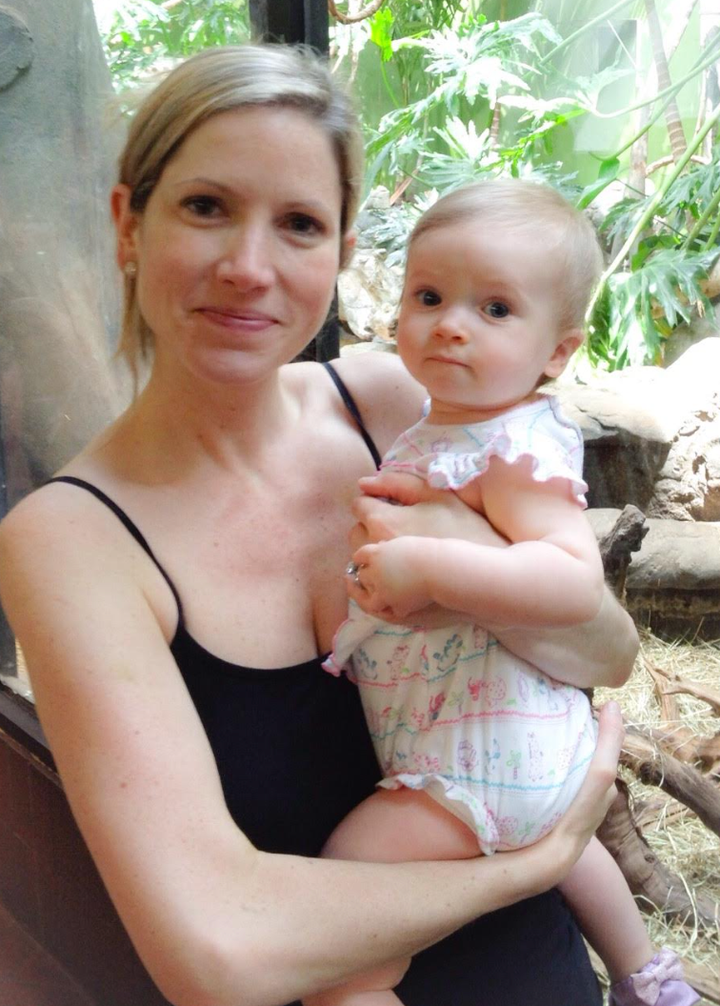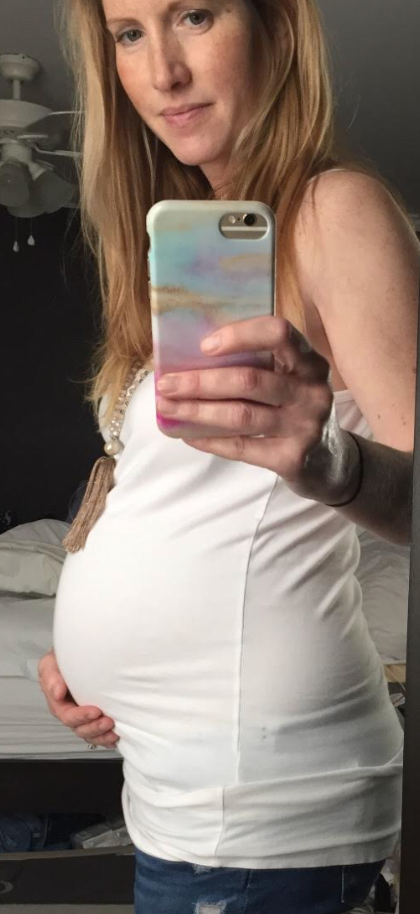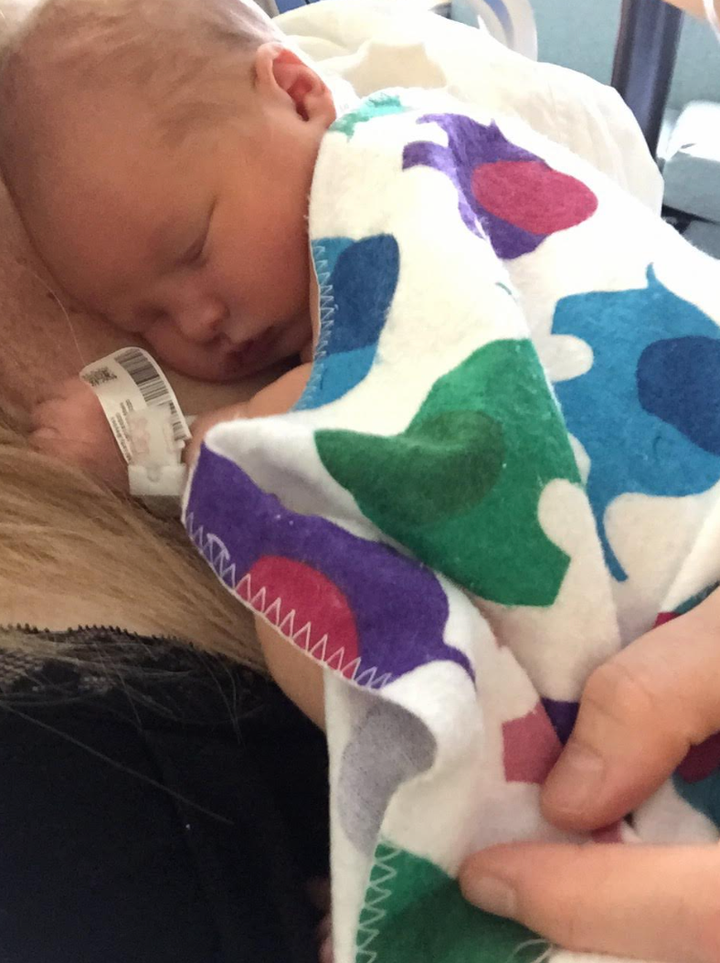From the moment my husband Ryan and I began trying to have a baby, I felt like a dark cloud was hanging over my head. When I was 29, I underwent several rounds of intrauterine insemination (IUI) in hopes of becoming pregnant, but all of them were negative and unsuccessful. It was overwhelming, to say the least. I eventually switched to in vitro fertilization (IVF) and I became pregnant with my first child. I felt grateful.
Our pregnancy was relatively typical and everything went according to plan, until I unexpectedly went into labor three weeks early and suffered a retained placenta.
This complication resulted in a postpartum hemorrhage and an emergency dilation and curettage, or D&C, which surgically removed the placenta from my uterine wall. The procedure was both physically and mentally traumatic.
After recovering, I was able to move forward and begin my life as a new mom.

Sixteen months later, I started IVF treatment again, and that dark cloud returned. Attempting to get pregnant with our second child proved to be even more challenging than the first time, and I spent four long years trying and failing with IVF. During that last year, I suffered four devastating losses in a row. The final one was the most difficult, as I felt like a complete failure to both myself and Ryan. It was absolutely devastating.
In response, my doctor basically threw a kitchen sink full of medications at me, but nothing worked.
I knew in my gut that something was really wrong — we just couldn’t seem to figure out what it was.
Several weeks after my fourth loss, we met with my endocrinologist to regroup and discuss next steps. “In my 30 years of practice, I have never seen a case like yours,” he told us. “I think you need to see a specialist.”
That recommendation led us to two words that would change everything.
It took a few months to get an appointment with the specialist, but once we talked with him, I felt reassured that we could figure things out.
We reviewed my medical history, ranging from the emergency D&C that I had after delivering my daughter to the four miscarriages and subsequent D&C’s I underwent in my last year of treatment.
The specialist told me that, based on my history, it was possible I had a condition called Asherman’s syndrome. He explained that this syndrome can occur when there has been a history of D&C and incomplete or recurrent miscarriages (among other causes).
In my case, it was both scenarios that contributed to my diagnosis.
Asherman’s syndrome involves a buildup of scar tissue in the uterus that can prevent an embryo from implanting properly in the area of scarring, and this can result in the loss of the pregnancy.
The specialist scheduled a hysteroscopy, an outpatient procedure performed in the hospital, which would verify whether I was suffering from Asherman’s syndrome and remove any scar tissue that may be present.
During my follow-up appointment, the specialist used a surgical tool with a camera attached to it to look at my uterine lining. He saw a significant amount of scar tissue in the uterus. It was especially concentrated at the top, known as the fundus, which was likely the site of where the embryos tried — but failed — to implant.
After the specialist removed some of my scar tissue, he confirmed that I had Asherman’s syndrome and it was likely to blame for my recurrent miscarriages.
“Why did it take so long to figure this out?” I asked him.
He explained that the condition is often diagnosed late — or not at all — because many tests cannot see it clearly enough. I was surprised by this diagnosis, considering all the imaging and testing I had throughout my treatment never indicated there was an issue. I was also relieved to know he recognized the cause.
He told me he would need to do this treatment three more times and that each treatment would be scheduled two weeks apart. In between my appointments, I needed to take estrogen, which would help to heal the endometrial lining in my uterus and prevent the scar tissue from growing back at the removal site.
The next six weeks felt endless. I just wanted to know if it worked and if I could try to get pregnant again.
The last appointment finally came and, after the specialist completed the fourth procedure, he put his hand on my hand and looked at me kindly and said, “The scar tissue didn’t come back. I don’t see anything there. We fixed it. I hope you can go have your baby now.”

I walked into the waiting room and hugged my husband. I felt like that dark cloud had finally been lifted from over my head.
The following week, we met with my endocrinologist to talk about our plan for our last remaining embryo. He said he wanted to consult his board to verify it was OK to put me through the transfer cycle again. Once he had approval, he told us that if this transfer was unsuccessful, I would need to pursue surrogacy.
While I was totally willing to take any opportunity that could help me become a mother again and give my daughter a sibling, part of me hoped we could make it happen on our own this last time.
We moved forward with the transfer protocol and waited the required two weeks before getting the bloodwork done. When we got the results, I was shocked to learn that my hCG hormone levels were doubling and doubling. I was cautiously optimistic due to my previous losses, but it seemed I was finally going to be able to bring my baby to full term — and we did. Our second child — my son, Noah, lucky embryo number seven, the last of the bunch — was born healthy and happy.

As a result of my treatment for Asherman’s syndrome, I was able to have my miracle baby, but it took almost a year and a half to get a diagnosis and I know I’m not the only one who has gone or is going through this.
It is now my mission to help other women who are struggling with recurrent pregnancy loss to be more informed and to encourage them to reach out to their doctor to ask about Asherman’s syndrome.
If you are under the age of 35 and have experienced recurrent pregnancy loss or difficulty getting pregnant for 12 months — or you’re over the age of 35 and are experiencing recurrent pregnancy loss for six months — you may be suffering from this condition and you may want to speak to your doctor about seeing a specialist.
If you think you may have Asherman’s syndrome, it’s important to be your own best advocate for your health. If you are experiencing recurrent losses, here are a few sample questions to consider asking your primary doctor or endocrinologist:
- Should I see a specialist based on my recurrent losses?
- Are you concerned this could be Asherman’s syndrome?
- Do you know of a specialist in my area that I could consult about the potential of Asherman’s syndrome?
I had no idea there was a reason I was experiencing so many losses — or that I could be treated for it and eventually welcome my son into the world.
I am grateful I was able to have a baby at all — much less two beautiful children — and to have my Asherman’s syndrome corrected. I know many women aren’t as fortunate. It’s heart-wrenching for me to watch friends deal with infertility and experience similar recurrent losses. It makes me wonder how many others don’t know about Asherman’s syndrome and if they could be helped. My hope is that sharing my story might make a difference in someone else’s life and offer a potential way to end her suffering too.
Lisa McCarty is a writer and a women’s health advocate for infertility, mental health and maternal health. Lisa also runs a strategic PR consulting firm focused on helping female entrepreneurs in health, wellness and fashion to share their stories in the global media.
Do you have a compelling personal story you’d like to see published on HuffPost? Find out what we’re looking for here and send us a pitch.
